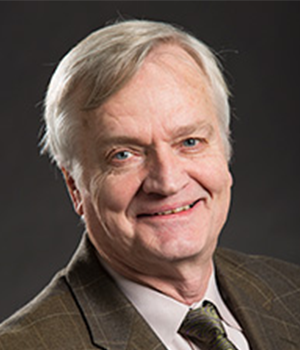
Erik Christensen
- Distinguished Professor Emerit, Civil and Environmental Engineering
Erik Christensen’s research activities relate to the fate and transport of pollutants in the aquatic environment, including quantifying sources and degradation of organic compounds. He has also contributed to models of the effect of pollutants on aquatic organisms. Throughout his career, Christensen has received significant funding for his research from the National Science Foundation as well as from other federal and state agencies. Christensen convened the first International Water Association specialist conference on sediment contamination and remediation in Milwaukee. On the UWM faculty since 1977, he is a fellow of the American Society of Civil Engineers and was named a University of Wisconsin–Milwaukee Distinguished Professors by the UW Board of Regents in 2010.
Education:
- PhD Environmental Engineering, University of California, Irvine, 1977
- MS Electrical Engineering, Technical University of Denmark, 1967
Research Focus:
- Aquatics pollutants
- Radiometric dating of sediments
- Source apportionment and degradation of environmental pollutants
- Storm water
- Membrane separation processes
- Multiple toxicity models
Publications:
Books:
Christensen, E.R. and A. Li. 2014. Physical and Chemical Processes in the Aquatic Environment. September, Wiley, Hoboken, New Jersey, 424 pp.
Selected Papers:
Christensen, E.R., R. Zhang, G.Codling, J.P. Giesy, and A. Li. 2019. Poly-and perfluoroalkyl compounds in sediments of the Laurentian Great Lakes: Loadings, temporal trends, and sources determined by positive matrix factorization. Environmental Pollution, 255, 113166.
Christensen, E.R., E. Steinnes, and O.A. Eggen. 2018. Anthropogenic and geogenic mass input of trace elements to moss and natural surface soil in Norway. Sci. Tot. Environ. 613-614, 371-378.
Christensen, E.R. 2018. Determination of sources of organic pollutants and trace elements in the environment. Invited presentation given at International Network of Environmental Forensics, Annual Conference, June 25-27, University of Utah, Salt Lake City, Utah.
Christensen, E.R., E. Steinnes, and O.A. Eggen. 2017. Trace element data for surface soil and moss in Norway analyzed by PMF and PCA with optional CLR transformation. Invited talk given at the Annual Congress on Soil Sciences, December 4-5, 2017, Madrid, Spain. J. Geol. Geophys. 2017, 6:6 (Suppl) DOI: 10.4172/2381-8719-C1-014.
Zou, Y., A.C. Aziz-Schwanbeck, H. Wei, E.R. Christensen, K. Rockne, and A. Li. 2016. Debromination of PBDEs in Arkansas water bodies analyzed by positive matrix factorization. Environ. Sci. Technol. 50, 1359-1367.
Zou, Y., L. Wang, and E.R. Christensen. 2015. Problems in the fingerprints based polycyclic aromatic hydrocarbons source apportionment analysis and a practical solution. Environmental Pollution, 205. 394-402.
Chang, J., G. Zhou, E.R. Christensen, R. Heideman, and J. Chen. 2014. Graphene-based sensors for detection of heavy metals in water: a review. Analytical and Bioanalytical Chemistry, 406, 3957-3975.
Zou, Y., E.R. Christensen, and A. Li. 2013. Characteristic pattern analysis of polybromodiphenyl ethers in Great Lakes sediments: a combination of eigenspace projection and positive matrix factorization analysis. Environmetrics 24, 41-50.
Wei, H., Y. Zou, A. Li, E.R. Christensen, and K.J. Rockne. 2013. Photolytic debromination pathway of polybrominated diphenyl ethers in hexane by sunlight. Environmental Pollution. 174, 194-200.
Wei, H., A.C Aziz-Schwanbeck, Y. Zou, M.B. Corcoran, A. Poghosyan, A. Li, K.J. Rockne, E.R. Christensen, and N.C. Sturchio. 2012. Polybromodiphenyl ethers and decabromodiphenyl ethane in aquatic sediments from southern and eastern Arkansas, United States. Environ. Sci. Technol. 46, 8017-8024.
Henry, R.C. and E.R. Christensen. 2010. Selecting an appropriate multivariate source apportionment model result. Environ. Sci. Technol. 44 (7), 2474-2481.
Christensen, E.R., K.O. Kusk, and N. Nyholm. 2009. Dose response regressions for algal growth and similar continuous endpoints: Calculation of effective concentrations. Environ. Toxicol. Chem. 28 (4), 826-835.
Soonthornnonda, P., E.R. Christensen, Y. Liu, and J. Li. 2008. A washoff model for stormwater pollutants. Sci. Tot. Environ. 402, 248-256.
Soonthornnonda, P. and E.R. Christensen. 2008. Source apportionment of pollutants and flows of combined sewer wastewater. Water Res. 42 (8-9), 1989-1998.
Christensen, E.R., Y. Zou, A. Li, K.J. Rockne, H. Wei, and A.C. Aziz, 2008. Modeling PAH, PCB, and PBDE sources and degradation in aquatic sediments based on factor analysis with nonnegative constraints. Invited presentation given at the International Conference on Water Scarcity, Global Changes, and Groundwater Management Responses held December 1-5, 2008 at the University of California, Irvine (UCI). Published in the conference proceedings (13 pp.) by UNESCO-IHP/UCI.
Christensen, E.R. and S. Arora. 2007. Source apportionment of PAHs in sediments using factor analysis by time records: Application to Lake Michigan, U.S.A. Water Res. 41 (1), 168-176.
Bzdusek, P.A., E.R. Christensen, C.M. Lee, U. Pakdeesusuk, and D.L. Freedman. 2006. PCB congeners and dechlorination in sediments of Lake Hartwell, South Carolina, determined from cores collected in 1987 and 1998. Environ. Sci. Technol. 40 (1), 109-119.
Bzdusek, P.A., J. Lu, and E.R. Christensen. 2006. PCB congeners and dechlorination in sediments of Sheboygan River, Wisconsin, determined by matrix factorization. Environ. Sci. Technol. 40 (1), 120-129.
Li, J., M.K. Mgonella, P.A. Bzdusek, and E.R. Christensen. 2005. PCB congeners and dechlorination in sediments of Upper Sheboygan River, Wisconsin. J. Great Lakes Res. 31 (2), 174-186.
Honors and Awards:
- University of California-Irvine: Outstanding graduate research award
- University of Wisconsin-Milwaukee: Outstanding research award
- Tau Beta Pi: Eminent Engineer
- Listed in American Men and Women of Science, Who is Who in Science and Engineering, Who is Who in America, Who is Who in the World, Who is Who in American Education
- American Society of Civil Engineers (Fellow)
Community Involvement:
- Friends of Milwaukee Symphony Orchestra
- Milwaukee Art Museum
- Schlitz Audubon Nature Center